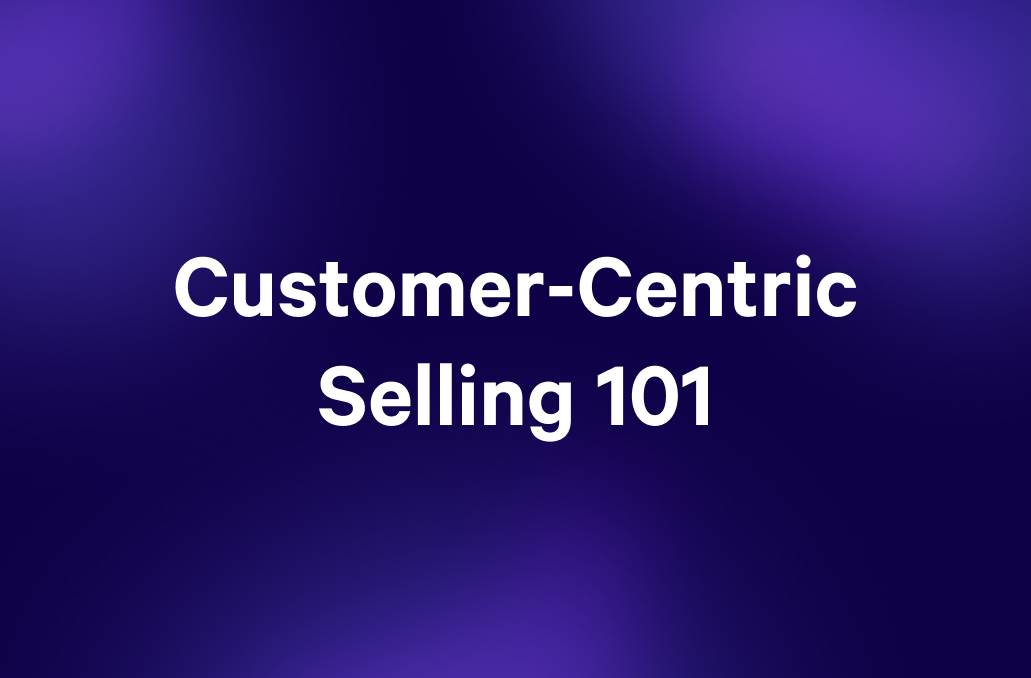One of the most frustrating aspects of sales can be its attritional nature. What, on paper, should be a simple process is often anything but. In fact, the whole process usually finds itself getting bogged down in bureaucracy: endless meetings and stalled approvals. Your head gently banging off the table top...
What if you could bypass all that back and forth and get straight to the decision-makers who can green-light your proposal immediately?
Enter top-down selling.
In this sales methodology, instead of navigating through lower-level management and working your way up, you target high-level executives from the outset—those with the power to make the big decisions.
In this comprehensive guide, we’ll discuss when to use it, evaluate its pros and cons, and share expert tactics for mastering the approach. Ready to put away the paracetamol and give that tabletop a rest? Let’s dive in…
Key takeaways
- Top-down selling focuses on engaging high-level decision-makers early in the sales process, facilitating smoother deal closures.
- It's particularly effective in complex B2B environments where executive buy-in can significantly accelerate the sales cycle.
- This strategy offers direct access to top-tier decision-makers, potentially leading to quicker consensus and larger deal sizes.
- To be successful, you'll need adept navigation of corporate hierarchies and a solid understanding of the business's strategic goals.
What is top-down selling?
Top-down selling is a strategic sales approach where you engage with top executives or decision-makers immediately. Instead of working your way up through lower-level contacts, you aim directly at the C-suite—the people with the power to say yes.
This method involves leveraging the influence and authority of top executives to streamline the sales process. By securing their buy-in early on, you set the tone for the rest of the organization, making it easier to get business proposals approved and projects green-lit.
When is top-down selling used?
Top-down selling is a powerful tool reserved for specific scenarios. It shines primarily in complex B2B sales environments where decisions impact multiple departments and require substantial investment.
The approach is particularly beneficial when the sales cycle is lengthy and tangled with layers of bureaucracy. By engaging with the highest-level decision-makers, you can bypass the unnecessary delays and resistance that typically occur lower down the chain.
It’s also ideal when introducing innovative products or services that can transform a business's operations. Convincing top executives first can lead to a domino effect, smoothly cascading approval throughout the organization.
The advantages and disadvantages of using top-down selling
Top-down selling can be a game-changing strategy, but it's not without its hurdles. While it offers a direct route to those with decision-making power, it also demands a keen understanding of corporate strategy and formidable networking skills.
Advantages
The advantages of top-down selling are significant, particularly in environments where the decision-making process is intricate and the stakes are high. First and foremost, this strategy offers direct access to key decision-makers who have the authority to close deals and allocate budgets swiftly.
Engaging with the top echelons can significantly shorten the sales cycle, as these individuals can push initiatives through without the need for extensive lower-level approvals.
When selling directly to senior leaders, a benefit you may realize is that you can align your solutions directly with strategic business objectives. High-level executives are focused on broad, impactful outcomes. If you can demonstrate how your product or service fits into their strategic vision, you're not just selling a product; you're becoming a partner in their success. This alignment can foster shorter sales cycles, long-term customer relationships, and loyalty.
Another advantage to consider is that top-down selling often results in larger deal sizes. Executives at this level typically oversee substantial budgets and are looking for comprehensive solutions that promise significant ROI. By positioning your offerings at this level, you're more likely to secure contracts that cover more extensive parts of the organization rather than piecemeal solutions tailored to smaller needs.
Disadvantages
The top-down selling approach isn't without its challenges.
The most glaring is the barriers to entry. Reaching and persuading top executives involves navigating through layers of gatekeepers and intense competition. These decision-makers are incredibly busy and are constantly bombarded with pitches. Standing out in their crowded inboxes and tight schedules requires persistence and a clear and compelling value proposition.
Another significant drawback is the dependence on the buy-in of a few key individuals. While getting the nod from top executives can streamline processes, it also means that your success is heavily dependent on the preferences and priorities of a small group of people. Shifts in executive leadership or strategic direction can jeopardize established relationships and ongoing deals.
Lastly, this strategy demands a high level of expertise and preparation. You really need to be able to walk the walk with this one—once you get in that door, top executives expect a thorough understanding of their industry, company, and competitive landscape.
Here's a summary table of the pros and cons we've discussed:
| Advantages | Disadvantages |
|---|---|
✅ Direct access to key decision-makers who can close deals and allocate budgets swiftly. | ❌ High barriers to entry: Reaching top executives requires navigating gatekeepers and intense competition. |
✅ Significantly shortens the sales cycle as top executives can push initiatives through quickly. | ❌ Dependence on the buy-in of a few key individuals, making success vulnerable to changes in leadership. |
✅ Aligns solutions with strategic business objectives, fostering long-term relationships and loyalty. | ❌ Demands a high level of expertise and preparation, requiring deep industry and company knowledge. |
✅ Often results in larger deal sizes as executives oversee substantial budgets and seek comprehensive solutions with significant ROI. |
3 actics to perform top-down selling
Mastering top-down selling requires supreme tactical execution. Here are three tips to help you effectively engage and win over top-level executives.
1. Build credibility with insight selling
Top executives are not just looking for products; they are looking for partners who understand their challenges and can offer insightful solutions. Start by conducting thorough research into their industry, company, and their specific challenges. Use this knowledge to tailor your approach, presenting your product or service as the solution to their unique problems. By demonstrating that you have done your homework and can speak their language, you build credibility and trust, making it easier to secure their attention and respect.
2. Align with business objectives
When engaging with high-level decision-makers, framing your pitch in terms of their strategic business objectives is crucial. Understand what drives their company—growth, efficiency, innovation, or cost reduction—and link your product directly to these goals. Show them how your solution can help achieve their targets or solve a significant pain point, making it a strategic investment rather than a discretionary purchase.
3. Leverage executive networking
Networking at the executive level can significantly boost your top-down selling strategy. Use your existing contacts to get introductions to high-level executives. Attend industry events, seminars, and conferences to meet C-suite individuals. Once you establish a connection, maintain it by offering regular value, such as industry insights, bespoke analyses, or updates on relevant technological advancements. This ongoing engagement helps keep you top of mind, facilitating easier access when you're ready to make your pitch.
5 top-down selling scenarios

1. Launching a new, innovative product
When introducing a cutting-edge product that could redefine industry standards or significantly enhance productivity, starting higher up is vital. High-level executives are often the visionaries looking for breakthrough advancements to keep their companies competitive. Presenting your innovative solution to them first can ensure a faster adoption cycle across their organization.
💡 Example:
Consider a new AI-powered predictive maintenance system for manufacturing. While plant managers might focus on immediate operational concerns, C-suite executives will be more interested in how this technology could revolutionize their entire production process, reduce downtime, and impact the bottom line.
✅ Action steps:
- Develop a pitch that focuses on strategic impact and ROI
- Prepare case studies demonstrating transformative results in similar industries
- Offer an executive-level demo or pilot program.
2. Entering a new market
Breaking into a new market or industry segment can be daunting. By targeting top executives, you can gain valuable insights into the market’s needs and tailor your approach accordingly. Securing an influential advocate in a new market can also pave the way for broader acceptance and credibility among other stakeholders.
💡 Example:
A SaaS company expanding from SMB to enterprise clients. While mid-level IT managers might focus on features and integration, CIOs and CTOs will be concerned with scalability, security, and alignment with long-term IT strategy.
✅ Action steps:
- Conduct thorough research on the new market's trends and pain points
- Leverage existing high-level connections for introductions and insights
- Tailor your value proposition to address C-suite concerns in the new market.
3. Contract renewal with strategic accounts
When it’s time to renew contracts with key clients, approaching top executives can help you renegotiate terms that are more favorable and reflective of the value your solutions have added over time. This scenario also provides an opportunity to expand the relationship, introducing additional services or products that meet newly emerging needs.
💡 Example:
A data analytics provider renewing a contract with a major retail client. Instead of simply renewing the existing services, engaging with the CMO or CEO could open discussions about how expanded data analytics could drive personalization strategies or inform expansion plans.
✅ Action steps:
- Prepare a comprehensive review of the value delivered to date
- Develop proposals for expanded services tied to the client's strategic goals
- Schedule high-level strategy sessions, not just renewal meetings
4. Crisis management
In situations where a client’s business faces sudden challenges or market shifts, stepping in with a top-down approach can demonstrate your commitment to their success. By directly engaging senior leadership, you can swiftly propose and implement solutions to address these urgent needs, solidifying your role as a trusted partner.
💡 Example:
A cybersecurity firm during a major data breach. While IT teams focus on immediate threat response, C-suite executives are concerned with reputation management, regulatory compliance, and long-term security strategy.
✅ Action steps:
- Develop rapid response protocols for crisis situations
- Prepare crisis-specific pitches that address both immediate and long-term concerns
- Offer post-crisis strategic planning sessions with executives
5. Complex sales with long cycles
In industries where sales cycles are typically long and involve multiple stakeholders, starting at the top can help streamline decision-making processes. By securing executive buy-in early, you minimize the potential for bottlenecks at lower levels and accelerate the overall sales process.
💡 Example:
Enterprise-wide implementation of a new CRM system. While department heads might get bogged down in specifics, a CEO will be focused on how this system can improve overall customer relationships, sales efficiency, and data-driven decision making.
✅ Action steps:
- Map out the full stakeholder landscape, identifying key influencers and decision-makers
- Develop a tiered communication strategy, with different messages for C-suite, middle management, and end-users
- Create a high-level project roadmap that executives can champion throughout the organization
Final thoughts
Top-down selling is a strategic approach that, when executed well, can significantly streamline and enhance your sales process. We hope this guide has given you the information and inspiration to take yours to the next level.
Are you looking to streamline further? Or give your proposals the wow factor that ensures your first impression is a lasting one? Our proposal software does exactly that. Try Qwilr today.
About the author

Brendan Connaughton|Head of Growth Marketing
Brendan heads up growth marketing and demand generation at Qwilr, overseeing performance marketing, SEO, and lifecycle initiatives. Brendan has been instrumental in developing go-to-market functions for a number of high-growth startups and challenger brands.
Frequently asked questions
Top-down selling targets the highest-level decision-makers from the start, aiming to secure executive buy-in early. This approach can expedite decision-making and align sales with strategic company goals. Conversely, bottom-up selling starts at lower or mid-level management, gradually building support and advocacy up the hierarchy, potentially enhancing user adoption and grassroots support.
Top-down sales forecasting begins with an overview of the market or economy and then narrows down to predict sales for a particular company. This method relies on broad market data and historical trends to project future sales broken down by regions or sales teams. It aligns sales targets with overall business objectives and external market conditions.
Top-down selling can profoundly impact B2B customer relationships by positioning the sales team as strategic partners rather than just vendors. Engaging top executives and aligning solutions with their strategic visions fosters a deeper, more consultative relationship, often leading to greater trust and long-term commitment.



